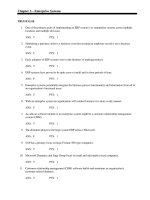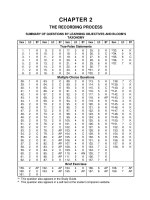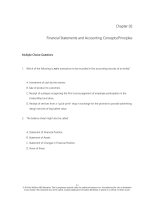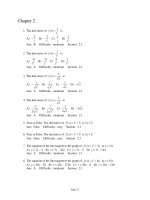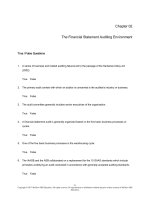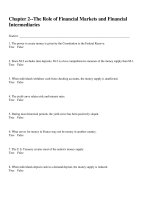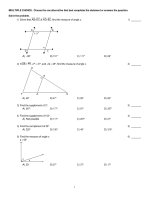Managerial accounting canadian 10th edition garrison test bank
Bạn đang xem bản rút gọn của tài liệu. Xem và tải ngay bản đầy đủ của tài liệu tại đây (4.71 MB, 108 trang )
02
Student: ___________________________________________________________________________
1. What would be the classification of corporate controller's salary?
A. Manufacturing cost.
B. Product cost.
C. Administrative cost.
D. Selling cost.
2. How should the cost of the fire insurance for a manufacturing plant be classified?
A. Prime cost.
B. Product cost.
C. Period cost.
D. Variable cost.
3. How would the cost of rent for a manufacturing plant generally be classified?
A. A product cost but not a prime cost.
B. Neither a product nor prime Cost.
C. A prime cost but not a product cost.
D. Both a prime cost and product cost.
4. For a lamp manufacturing company, the cost of the insurance on its vehicles that deliver lamps to customers
is best described as a:
A. Prime cost.
B. Manufacturing overhead cost.
C. Period cost.
D. Differential cost of a lamp.
5. For a manufacturing company, which of the following is an example of a period cost rather than a product
cost?
A. Depreciation of factory equipment.
B. Wages of salespersons.
C. Wages of machine operators.
D. Insurance on factory equipment.
6. Which of the following would be considered a product cost for external financial reporting purposes?
A. Cost of a warehouse used to store finished goods.
B. Cost of guided public tours through the company's facilities.
C. Cost of travel necessary to sell the manufactured product.
D. Cost of sand spread on the factory floor to absorb oil from manufacturing machines.
7. Which of the following would NOT be treated as a product cost for external financial reporting purposes?
A. Depreciation on a factory building.
B. Salaries of factory workers.
C. Indirect labour in the factory.
D. Advertising expenses.
8. What would be the classification of the transportation costs incurred by a manufacturing company to ship its
product to its customers?
A. Product cost.
B. Manufacturing overhead.
C. Period cost.
D. Administrative cost.
9. The advertising costs incurred by Pepsi to air its commercials during the hockey season can best be described
as a:
A. Variable cost.
B. Fixed cost.
C. Prime cost.
D. Conversion cost.
10. Micro Computer Company has set up a toll-free telephone line for customer inquiries regarding computer
hardware produced by the company. How would the cost of this toll-free line be classified?
A. Product cost.
B. Manufacturing overhead.
C. Direct labour.
D. Period cost.
11. How would the wages of factory maintenance personnel usually be classified?
A. Direct labour and manufacturing overhead.
B. Indirect labour and manufacturing overhead.
C. Direct labour and period cost.
D. Indirect labour and period cost
12. Prime costs consist of:
A. Direct Labour and Manufacturing Overhead.
B. Direct Material and Direct Labour.
C. Direct Material and Manufacturing overhead.
D. Direct Material, Direct Labour and Manufacturing Overhead.
13. What does manufacturing overhead cost consist of?
A. All manufacturing costs.
B. All manufacturing costs, EXCEPT direct materials and direct labour.
C. Indirect materials but NOT indirect labour.
D. Indirect labour but NOT indirect materials.
14. A brewery produces many variety of beer. If the cost object is a particular brand of beer the factory
supervisor salary is classified a/an _____________ cost of the brand of beer and a _____________ cost of the
entire division.
A. Direct, Common
B. Indirect, Common
C. Direct, Prime
D. Fixed, Period
15. Rossiter Company failed to record a credit sale at the end of the year, although the reduction in finished
goods inventories was correctly recorded when the goods were shipped to the customer. Which one of the
following statements is correct?
A. Accounts receivable was not affected, inventory was not affected, sales were understated, and cost of goods
sold was understated.
B. Accounts receivable was understated, inventory was overstated, sales were understated, and cost of goods
sold was overstated.
C. Accounts receivable was not affected, inventory was understated, sales were understated, and cost of goods
sold was understated.
D. Accounts receivable was understated, inventory was not affected, sales were understated, and cost of goods
sold was not affected.
16. What is the outcome if the cost of goods sold is greater than the cost of goods manufactured?
A. Work-in-process inventory has decreased during the period.
B. Finished goods inventory has increased during the period.
C. Total manufacturing costs must be greater than cost of goods manufactured.
D. Finished goods inventory has decreased during the period.
17. Last month, when 10,000 units of a product were manufactured, the cost per unit was $60. At this level of
activity, variable costs were 50% of total unit costs. If 10,500 units are manufactured next month and cost
behaviour patterns remain unchanged, how will costs be affected?
A. Total variable costs will remain unchanged.
B. Fixed costs will increase in total.
C. Variable cost per unit will increase.
D. Total cost per unit will decrease.
18. Which of the following statements regarding variable cost is true?
A. Variable cost increases on a per unit basis as the number of units produced increases.
B. Variable cost remains constant on a per unit basis as the number of units produced increases.
C. Variable cost remains the same in total as production increases.
D. Variable cost decreases on a per unit basis as the number of units produced increases.
19. Within the relevant range, what is the difference between variable costs and fixed costs?
A. Variable costs per unit fluctuate and fixed costs per unit remain constant.
B. Variable costs per unit are constant and fixed costs per unit fluctuate.
C. Total variable costs and total fixed costs are constant.
D. Total variable costs and total fixed costs fluctuate.
20. The Target store in your home town is one of many Target department stores across the province. Some of
the costs associated with the store in your home town last month appear below:
The Shoe Department is one of many departments in the home town store. The direct costs of the Shoe
Department total:
A. $80,000
B. $88,000
C. $97,000
D. $108,000
21. Which of the following best defines an opportunity cost?
A. The difference in total costs from selecting one alternative instead of another.
B. The benefit forgone by selecting one alternative instead of another.
C. A cost that may be saved by NOT adopting an alternative.
D. A cost that may be shifted to the future with little or no effect on current operations.
22. To what does the term differential cost refer?
A. A difference in cost that results from selecting one alternative instead of another.
B. The benefit forgone by selecting one alternative instead of another.
C. A cost that does not entail any dollar outlay, but which is relevant to the decision-making process.
D. A cost that continues to be incurred even though there is no activity.
23. Which of the following costs is often important in decision making, but is omitted from conventional
accounting records?
A. Fixed cost.
B. Sunk cost.
C. Opportunity cost.
D. Indirect cost.
24. When a decision is made among a number of alternatives, the benefit that is lost by choosing one alternative
over another is called what?
A. Realized cost.
B. Opportunity cost.
C. Conversion cost.
D. Accrued cost.
25. What does conversion cost consist of?
A. Manufacturing overhead cost.
B. Direct materials and direct labour cost.
C. Direct labour cost.
D. Direct labour and manufacturing overhead cost.
26. Prime cost consists of direct materials and what?
A. Direct labour.
B. Manufacturing overhead.
C. Indirect materials.
D. Cost of goods manufactured.
27. Which one of the following costs should NOT be considered a direct cost of serving a particular customer
who orders a customized personal computer by phone directly from the manufacturer?
A. The cost of the hard disk drive installed in the computer.
B. The cost of shipping the computer to the customer.
C. The cost of leasing a machine on a monthly basis that automatically tests hard disk drives before they are
installed in computers.
D. The cost of packaging the computer for shipment.
28. Which one of the following costs should NOT be considered an indirect cost of serving a particular
customer at a Dairy Queen fast food outlet?
A. The cost of the hamburger patty in the burger the customer ordered.
B. The wages of the employee who takes the customer's order.
C. The cost of heating and lighting the kitchen.
D. The salary of the outlet's manager.
29. Green Company's costs for the month of August are as follows:
The beginning work-in-process inventory is $16,000 and the ending work-in-process inventory is $9,000. What
is the cost of goods manufactured for the month?
A. $105,000.
B. $132,000.
C. $138,000.
D. $112,000.
30. A manufacturing company prepays its insurance coverage for a three-year period. The premium for the three
years is $2,700 and is paid at the beginning of the first year. Eighty percent of the premium applies to
manufacturing operations and 20% applies to selling and administrative activities. What amounts should be
considered product costs and period costs respectively for the first year of coverage?
A. Option A
B. Option B
C. Option C
D. Option D
31. You have the following data:
Which of the following represents the beginning work-in-process inventory?
A. $20.
B. $15.
C. $55.
D. $25.
32. During the month of May, Bennett Manufacturing Company purchases $43,000 of raw materials. The
manufacturing overhead totals $27,000 and the total manufacturing costs are $106,000. Assuming a beginning
inventory of raw materials of $8,000 and an ending inventory of raw materials of $6,000, what must be the total
for direct labour?
A. $34,000.
B. $38,000.
C. $36,000.
D. $45,000.
33. You are given the following data for January:
Which of the following is the cost of goods manufactured?
A. $89,000.
B. $78,000.
C. $79,000.
D. $80,000.
34. During the month of June, Reardon Company incurs $17,000 of direct labour and $8,500 of manufacturing
overhead, and purchases $15,000 of raw materials. Between the beginning and the end of the month, the
raw-materials inventory increases by $2,000, the finished goods inventory increases by $1,500, and the
work-in-process inventory decreases by $3,000. What is the cost of goods manufactured?
A. $38,500.
B. $40,500.
C. $41,500.
D. $43,500.
35. Mueller Company reports the following data for the year just ended:
What was the beginning work-in-process inventory?
A. $300,000.
B. $500,000.
C. $1,300,000.
D. $100,000.
36. Williams Company's direct labour cost is 25% of its conversion cost. If the manufacturing overhead cost for
the last period is $45,000 and the direct materials cost is $25,000, what is the direct labour cost?
A. $15,000.
B. $60,000.
C. $33,333.
D. $20,000.
37. The Lyons Company's cost of goods manufactured was $120,000 when its sales were $360,000 and its gross
margin was $220,000. If the ending inventory of finished goods was $30,000, what was the beginning inventory
of finished goods?
A. $20,000.
B. $50,000.
C. $110,000.
D. $150,000.
38. The gross margin for Cushing Company for the first quarter of last year was $325,000 when sales were
$700,000. The beginning inventory of finished goods was $60,000, and the ending inventory of finished goods
was $85,000. What was the cost of goods manufactured for the first quarter?
A. $375,000.
B. $350,000.
C. $400,000.
D. $385,000.
39. Last month, a manufacturing company had the following operating results:
What was the cost of goods manufactured for the month?
A. $413,000
B. $411,000
C. $412,000
D. $463,000
40. The following information was provided by Wilson Company for the year just ended:
What was the cost of goods manufactured for the year?
A. $314,725.
B. $335,275.
C. $325,000.
D. $464,725.
41. The following information was provided by Grand Company for the year just ended:
What was the cost of goods manufactured for the year?
A. $95,345.
B. $104,655.
C. $395,345.
D. $404,655.
42. The following inventory valuation errors were discovered by Knox Corporation's new controller just after
the annual financial statements were published at the end of Year 3.
The net income for Knox in each of these years was:
Assuming there were no income taxes, what was the adjusted net income in each year?
A. Option A
B. Option B
C. Option C
D. Option D
43. Delta Merchandising, Inc., has provided the following information for the year just ended:
What was the ending inventory for the company at year-end?
A. $65,450.
B. $24,500.
C. $14,050.
D. $9,950.
44. The beginning balance of the raw materials inventory account for May was $27,500. The ending balance for
May was $28,750, and $128,900 of raw materials were used during the month. What was the cost of the
materials purchased during the month?
A. $131,300.
B. $127,650.
C. $130,150.
D. $157,650.
45. Gabel Inc. is a merchandising company. Last month, the company's merchandise purchases totalled
$63,000. The company's beginning merchandise inventory was $13,000, and its ending merchandise inventory
was $15,000. What was the company's cost of goods sold for the month?
A. $91,000.
B. $63,000.
C. $65,000.
D. $61,000.
46. Haack Inc. is a merchandising company. Last month, the company's cost of goods sold was $84,000. The
company's beginning merchandise inventory was $20,000, and its ending merchandise inventory was $18,000.
What was the total amount of the company's merchandise purchases for the month?
A. $86,000.
B. $82,000.
C. $84,000.
D. $122,000.
47. During January, the cost of goods manufactured was $93,000. The beginning finished goods inventory was
$16,000, and the ending finished goods inventory was $20,000. What was the cost of goods sold for the month?
A. $129,000.
B. $89,000.
C. $93,000.
D. $97,000.
48. Sally Smith is employed in the production of various electronic products, and she earns $8 per hour. She is
paid time-and-a-half for work in excess of 40 hours per week. During a given week, she worked 45 hours and
had no idle time. How much of her week's wages would be charged to manufacturing overhead?
A. $60.
B. $20.
C. $40.
D. $0.
49. During the first week of April, Gillian worked a total of 50 hours assembling products and had no idle time.
Gillian is paid $15 per hour for regular time, and is paid time-and-a-half for all hours in excess of a 40-hour
week. How much of Gillian's wages for the week should be charged to direct labour?
A. $600.
B. $225.
C. $750.
D. $975.
50. Robert Smith earns $16 per hour assembling products. For each hour over 40 he works in a week he is paid
time-and-a-half. During a given week, he worked 40 hours for which 3 hours were idle time. How much of his
weekly wages would be charged to direct labour?
A. $640.
B. $592.
C. $688.
D. $48.
The following data (in thousands of dollars) have been taken from the accounting records of Karling
Corporation for the year just ended.
51. What was the cost (in thousands of dollars) of the raw materials used in production during the year?
A. $190.
B. $90.
C. $150.
D. $160.
52. What was the cost of goods manufactured (finished) for the year (in thousands of dollars)?
A. $540.
B. $500.
C. $570.
D. $590.
53. What was the cost of goods sold (in thousands of dollars) for the year?
A. $700.
B. $500.
C. $660.
D. $580.
54. What was the net income (in thousands of dollars) for the year?
A. $150.
B. $200.
C. $490.
D. $250.
The following data (in thousands of dollars) have been taken from the accounting records of Karlana
Corporation for the year just ended.
55. What was the cost of the raw materials used in production (in thousands of dollars) during the year?
A. $180.
B. $40.
C. $120.
D. $160.
56. What was the cost of goods manufactured (finished) for the year (in thousands of dollars)?
A. $530.
B. $520.
C. $500.
D. $460.
57. What was the net income (in thousands of dollars) for the year?
A. $410.
B. $110.
C. $40.
D. $180.
The following data (in thousands of dollars) have been taken from the accounting records of Karlist
Corporation for the just completed year.
58. What was the cost of the raw materials used in production (in thousands of dollars) during the year?
A. $240.
B. $190.
C. $170.
D. $250.
59. What was the cost of goods manufactured (finished) for the year (in thousands of dollars)?
A. $450.
B. $460.
C. $530.
D. $540.
60. What was the cost of goods sold (in thousands of dollars) for the year?
A. $610.
B. $410.
C. $490.
D. $570.
61. What was the Gross Margin (in thousands of dollars) for the year?
A. $350.
B. $130.
C. $390.
D. $190.
The following data pertain to Harriman Company's operations during July:
62. What was the beginning work-in-process inventory?
A. $10,000.
B. $14,000.
C. $1,000.
D. $4,000.
63. What was the ending finished goods inventory?
A. $17,000.
B. $12,000.
C. $7,000.
D. $2,000.
Bergeron Inc. reported the following data for last year:
64. Which of the following is the prime cost?
A. $900.
B. $800.
C. $1,200.
D. $700.
65. Which of the following is the conversion cost?
A. $700.
B. $800.
C. $900.
D. $1,200.
66. Which of the following is the cost of goods manufactured?
A. $1,250.
B. $1,200.
C. $1,220.
D. $1,150.
Geneva Steel Corporation produces large sheets of heavy gauge steel. The company showed the following
amounts relating to its production for the year just completed:
67. What was the balance of the finished goods inventory at the end of the year?
A. $95,000.
B. $50,000.
C. $193,000.
D. $45,000.
68. What was the cost of goods manufactured for the year?
A. $171,000.
B. $160,000.
C. $243,000.
D. $244,000.
69. What was the manufacturing overhead cost for the year?
A. $84,000.
B. $78,000.
C. $56,000.
D. $72,000.
Boardman Company reported the following data for the month of January:
70. If raw materials costing $35,000 were purchased during January, what were the total manufacturing costs
for the month?
A. $145,000.
B. $144,000.
C. $151,000.
D. $146,000.
71. Assuming that cost of goods sold for January was $124,000, what was the net income for January?
A. $61,000.
B. $26,000.
C. $51,000.
D. $25,000.
72. Which of the following is Boardman Company's total conversion cost for January?
A. $110,000.
B. $170,000.
C. $135,000.
D. $130,000.
73. Assuming that cost of goods sold for Boardman Company for January was $140,000, what was the cost of
goods manufactured for the month?
A. $140,000
B. $135,000
C. $145,000
D. $139,000
At a sales volume of 32,000 units, CD Company's total fixed costs are $64,000 and total variable costs are
$60,000. The relevant range is 30,000 to 55,000 units.
74. If CD Company sells 43,000 units, what is the total expected cost (Do not round your intermediate
calculations)?
A. $146,000.
B. $166,625.
C. $144,625.
D. $124,000.
75. If CD Company sells 50,000 units, what is the total expected cost per unit? (Do not round intermediate
computations). Round final answer to the nearest cent.
A. $3.20.
B. $2.48.
C. $3.88.
D. $3.16.
76. All costs incurred in a merchandising firm are considered to be period costs.
True False
77. In a manufacturing firm, depreciation is always considered a product cost for external financial reporting
purposes.
True False
78. In external financial reports, factory utilities costs may be included in an asset account on the balance sheet
at the end of the period.
True False
79. Advertising costs are considered product costs for external financial reports since they are incurred in order
to promote specific products.
True False
80. Property taxes and insurance premiums paid on a factory building are examples of manufacturing overhead.
True False
81. Manufacturing overhead combined with direct materials is known as conversion cost.
True False
82. If the ending inventory of finished goods is understated, net income will be overstated.
True False
83. In a manufacturing company, goods available for sale equals the sum of the cost of goods manufactured and
the beginning finished goods inventory.
True False
84. Variable costs are costs whose per unit costs vary as the activity level rises and falls.
True False
85. On a per unit basis, a fixed cost varies inversely with the level of activity.
True False
86. The following would typically be considered indirect costs of manufacturing a particular Boeing 747 to be
delivered to Singapore Airlines: electricity to run production equipment, the factory manager's salary, and the
cost of the General Electric jet engines installed on the aircraft.
True False
87. When raw materials are used in production, their costs are transferred to the work in process inventory
account as direct materials.
True False
88. The following costs should be considered by a law firm to be indirect costs of defending a particular client
in court: rent on the law firm's offices, the law firm's receptionist's wages, the costs of heating the law firm's
offices, and the depreciation on the personal computer in the office of the attorney who has been assigned the
client.
True False
89. As goods are completed their cost is transferred from the Work in Process account to the Finished Goods
account where they await sale to customer.
True False
90. Some companies classify labour fringe benefits for direct labour workers as part of the direct labour cost
and some classify these costs as manufacturing overhead.
True False
91. Stony Electronics Corporation manufactures a portable radio designed for mounting on the wall of the
bathroom. The following list represents some of the different types of costs incurred in the manufacture of these
radios:
1) The plant manager's salary.
2) The cost of heating the plant.
3) The cost of heating executive offices.
4) The cost of printed circuit boards used in the radios.
5) Salaries and commissions of company salespersons.
6) Depreciation on office equipment used in the executive offices.
7) Depreciation on production equipment used in the plant.
8) Wages of janitorial personnel who clean the plant.
9) The cost of insurance on the plant building.
10) The cost of electricity to light the plant.
11) The cost of electricity to power plant equipment.
12) The cost of maintaining and repairing equipment in the plant.
13) The cost of printing promotional materials for trade shows.
14) The cost of solder used in assembling the radios.
15) The cost of telephone service for the executive offices.
Required:
Classify each of the items above as product (inventoriable) cost or period (noninventoriable) costs for the
purpose of preparing external financial statements.
92. Bill Pope has developed a new device that is so exciting he is considering quitting his job in order to
produce and market it on a large-scale basis. Bill will rent a garage for $300 per month for production purposes.
Utilities will cost $40 per month. Bill has already taken an industrial design course at the local community
college to help prepare for this venture. The course cost $300. Bill will rent production equipment at a monthly
cost of $800. He estimates the material cost will be $5 per unit, and the labour cost will be $3 per unit. He will
hire workers and spend his time promoting the product. To do this, he will quit his job, which pays $3,000 per
month. Advertising and promotion will cost $900 per month.
Required:
Complete the chart below by placing an "X" under each heading that helps to identify the cost involved. You
can place an "X" under more than one heading for a single cost: for example, a cost may be a sunk cost, an
overhead cost, and a product cost; you would place an "X" under each of these headings opposite the cost.
* Between the alternatives of going into business to make the device or not going into business to make
the device. See column heading "Differential Cost".
* Between the alternatives of going into business to make the device or not going into business to make the
device.
93. Logan Products, a small manufacturer, has submitted the items below concerning last year's operations. The
president's secretary, trying to be helpful, has alphabetized the list.
Required:
a.) Prepare a schedule of cost of goods manufactured in good form for the year.
b.) Determine the cost of goods sold for the year.
94. Lake Company recorded the following data for the month of January 20xx:
Required:
a) Compute the amount of direct materials used in January.
b) List and total the Manufacturing Overhead costs for the month of January.
c) Compute the Cost of Goods Manufactured.
Note: It may be helpful to prepare a Cost of Goods Manufactured statement in rough form but it is not
required. You may use short forms in your answers for DM, DL etc.
